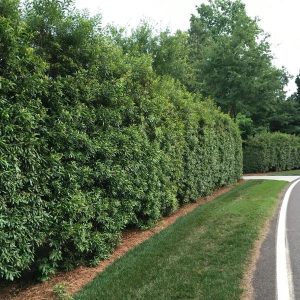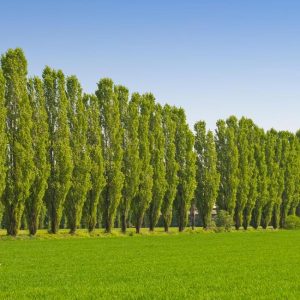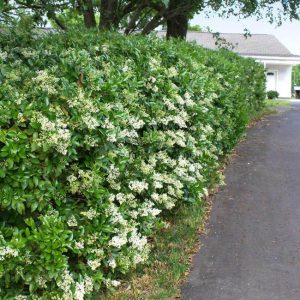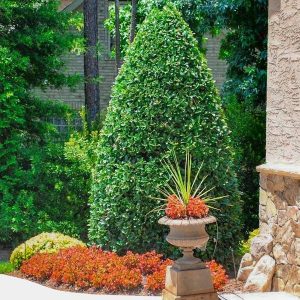Best 7 Trees For Privacy To Grow In Alabama
You can add natural beauty to your Alabama yard while adding privacy with evergreen trees. We all enjoy a little privacy every now and then, don’t we? The number of subdivisions in your backyard keeps growing every time you turn around.
There are many reasons and needs for a privacy hedge. You can block out unsightly elements of your landscape by growing a living privacy fence. You can use shrubs to block out or dampen noise from nearby highways or noisy neighbors.
We have found 6 best privacy trees for Alabama all zones.
Brodie Eastern Red Cedar Tree

- Evergreens native to North America
- Durable, tough, and resistant to drought
- Bird Magnet and Wildlife Cover
- Beautiful texture
- Wood with an aromatic scent
A tough old native tree like the Eastern Red Cedar (Juniperus virginiana) is well worth respecting. Throughout North America you will find it growing in the wilds – from the East Coast through Texas and North Dakota to the West Coast. Despite harsh weather conditions, you will find these trees flourishing.
This plant will do well on hot and dry sites and will not be bothered by road salt or open exposed areas. Eastern Red Cedar trees won’t be affected by air pollution, shallow and rocky soils, or even soils where black walnut grows. This one is usually passed by deer as well.
You should choose this tree if you love birds. Birds will be drawn to Eastern Redcedar, including robins, juncos, warblers, sparrows, quail, grouse, pheasants, and wild turkeys. In the branches, they’ll happily build nests and roost.
Birds use this bark to build nests because its shredding nature is hidden from view but useful for building nests. The female tree sheds dark blue berries-like conical fruits that provide food for a number of bird species.
During the growing season, the foliage will range from silvery blue to dark green. A purplish color changes as the seasons change, providing a beautiful accent against a home or outbuilding. Winter is a time to embrace the colors.
Pacific Wax Myrtle

- This great hedge will enhance your backyard
- Growing quickly…3-5 feet per year!
- It’s Evergreen All Year Long!
The Wax Myrtle is perfect for a partition or screen. This shrub has dense foliage and a rapid growth rate that makes it an ideal choice for shrubs. They’re great as a property line delineator or to enhance your front porch.
With its fragrant foliage and berries, the Way Myrtle makes a wonderful addition to your outdoor living space. In the fall, the fruit matures and remains in the tree during the winter, attracting a variety of birds. Additionally, due to its nitrogen-returning property and ability to repel insects organically, myrtle is ‘green’ throughout.
Lombardy Poplar Tree

- An excellent privacy screen or windbreak
- A perfect solution for areas where height is needed but space is tight
- Low Maintenance and Very Adaptable
A fast growing tree that grows upright with a narrow canopy, the Lombardy Poplar is native to northern Europe. Popular to grow in streets, windbreaks, and privacy screens, the Lombardy Poplar is a highly sought after street tree. The wide range of zones where it grows means that it can be cultivated almost anywhere in the US!
There are few trees that offer a faster green screen. It will not take long for this tree to fill in where you need it, because it grows at about 6 feet per year. Despite being a non-evergreen, the Lombardy poplar’s close and dense branches offer protection in the winter. Fallen leaves reflect light which helps your home retain heat in the cold of winter, reducing your heating costs.
Key Features:
- Grows from zones 3 to 9 in most of the US!
- Growing at an incredible rate. We have heard reports of this tree growing as fast as 12 feet per year once established.
- The shape. Uniquely elegant is this tall, upright columnar tree. Trees that can fit into narrow spaces are hard to find. There is no need to look any further than Lombardy Poplar. Even small yards can fit this tree since it is 10 to 12 feet wide.
You can boost your Lombardy Poplar tree’s growth rate by planting it in full sun, fertilizing the tree each spring with a balanced slow release fertilizer, and watering well, especially during periods of drought during summer months.
Cryptomeria Radicans

- Feathery, fragrant foliage
- Interest during the winter
- The Japanese national tree
Do you want a tree that adds unique style without needing constant maintenance? Known as the Japanese cedar, Cryptomeria Radicans trees are perfect for you! As a privacy screen, this tree is ideal. Cryptomeria Trees look beautiful, whether they are grouped together or stood alone. Japan’s national tree is a beautiful specimen. It is regularly planted in temples and shrines.
Its feathery foliage is soft, dense, and scented. Cryptomeria Trees grow to a height of 30-40 feet and spread to a width of 15-20 feet. In a single year, it grows between three and five feet. Adaptable to many soil types, even hard compact clay, this tree is easy to maintain. Sunlight to partial shade is ideal. As soon as it matures and establishes, it is also drought and disease resistant. When it comes to the Cryptomeria Tree, there is little to worry about.
In addition to being ornamental and versatile, Cryptomeria is also hardy. A colorful display is provided by the Cryptomeria tree throughout the year! Emerald green needles dominate most of the year. When the foliage is young, the leaves are a brighter green that deepens with age. The Cryptomeria develops a bronze tint as cold weather sets in. Reddish brown bark covers the tree. Columnar to narrow pyramid-shaped, this conifer is upright.
Waxleaf Privet Hedge

- Emerald foliage that is dense and glossy
- In spring, they bloom in white
- Fragrant and pleasant to the senses
- Hedges and windbreaks are great for this species
- Stunning shapes can be created when pruned
- Drought-resistant, anti-pest and anti-disease
- Partial shade, full sun
A garden marvel, the Waxleaf Privet (Ligustrum japonicum ‘Texanum’) is unlike any other evergreen shrub. Due to its adaptability, natural beauty, and high rate of survival, this evergreen is an exceptional choice for any gardener.
Winter is a time for broad, deep emerald green leaves to appear on this evergreen shrub. Despite the shade of green already being alluring, the waxleaf gets its name from its glossy sheen.
A sprinkling of fragrant white blooms embellishes the foliage in spring on this plant. In the fall, they turn to blackish berries that birds love. These flower clusters add softness and charm to this plant’s beauty.
In addition to its fruit, the blooms of the privet shrub are an excellent food source for pollinators. If you keep your camera ready, you’ll capture beautiful butterflies as they flutter into your yard looking for food.
Although it may appear as merely a green pillar of foliage, Waxleaf Privet is much more than that. Privet shrubs can be pruned into a variety of shapes and sizes based on your growing area’s requirements, similar to your typical hedge plant.
In addition to its great color and variety, this plant is also remarkably hardy! Additionally, this plant is salt-tolerant and drought-tolerant, as well as disease-resistant and resilient against pests.
Adding Waxleaf Privet to your garden is a smart decision because this plant is so hardy, adaptable, and has so many uses.
Oak Leaf Holly Tree

- Similar to the leaves of oak trees, but softer
- Green emerald color
- The foliage is dense and lush
- Great for privacy hedges or as a standalone product
That’s one big boy! Oakleaf Holly grows a full foot in the spring each year, reaching its mature height and width in a short time. To keep unwanted people and animals from entering (or outside! ), do you need a huge hedge? This large group forms an impressive shielding hedge of spiky spikes.
A Holly with beautifully shaped leaves – you guessed it – like Oak leaves, Oakleaf is the premier Holly. As you may be surprised to learn, unlike many other Holly species, this evergreen starts out with bronze or even burgundy leaves in the spring. Before they mature into that deep classic Holly green, they keep this beautiful sheen for a couple of weeks.
The Oakleaf Holly is excellent for making bright orange-red berries all fall and winter because it does not require another Holly to pollinate.
Although these giants are a little too big to plant in most foundation plantings on their own, they can be sheared and kept at any size you want. There’s no need to babe these plants, they thrive in full sun, light shade, and rich soil.
You’ve found your plant if you need a massive, quick-growing shrub that stays green year round.

